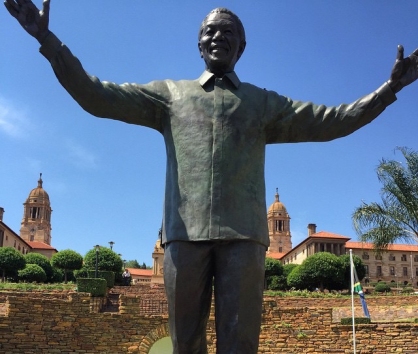
Students abroad in Fordham’s Pretoria Program take note of the beauty and extreme poverty in the area. Shannon Marcoux/The Fordham Ram
By Shannon Marcoux
SOUTH AFRICA — When we first arrived in South Africa, I was not sure at all what to expect. Driving from the airport in Johannesburg to our house in Pretoria, we saw zebras along the side of the highway in a nature preserve where we would later go hiking. Maybe this would really be like The Lion King? Although we did get to spend time petting lions and giraffes, I quickly found out that, with 11 official languages and at least a dozen distinct cultures, there was far more to South Africa than the amazing animals and beautiful landscape.
Countless people have told us that there are two South Africas: a wealthy, urban and suburban South Africa and a more rural, incredibly impoverished South Africa.
We live in Hatfield, a section of Pretoria comprising of the University of Pretoria and the surrounding area. We stay at a bed and breakfast with beautiful gardens and a pool, and we work out at the facility where the Argentinian soccer team trained and stayed during the World Cup. Our neighborhood is notably safe and is home to dozens of shops, bars and restaurants.
In our free time, we have gone to a blues festival at a world heritage site, joined a drum circle, visited a Buddhist temple for Chinese New Year and enjoyed many of the other fun things that Pretoria and “Joburg,” an expression for Johannesburg, have to offer. As part of our itinerary in the coming months, we will go on a safari, whitewater raft in Swaziland, hike Table Mountain, explore Cape Town, hang on the beach in Durban, camp in the Drakensberg Mountains in Lesotho and road trip through several countries in southern Africa to cap off our semester.
Our program has all the makings of a traditional study abroad experience: traveling, great food, nightlife and cultural experiences. However, every country has good parts and bad parts. The tourist-friendly areas and areas where the gritty realities of everyday life are far more apparent. The Ubuntu program has given me the unique opportunity of fully engaging with both.
Twice a week, I travel about 40 minutes outside the city to Sjambok primary school in the semi-rural village of Erasmus, a place where these gritty realities are ever-present. Erasmus’ location leaves it outside of any city’s jurisdiction, which means the village does not benefit from public services such as waste management or a police department. All matters go through the village’s leader, who makes the ultimate decision for the community. Many of the people who live in the village rely on job opportunities provided by the federal government and on government welfare income.
The students at the primary school receive a small meal in the mid-morning, which for some is the only meal they will eat that day. Due to a shortage of teachers, the students are often left completely unsupervised and instructed to complete a worksheet or read silently.
Studies have shown that despite higher education funding and better trained teachers, South African students perform significantly worse than students in many of their neighboring countries due to this lack of teacher presence in the classroom. The issues of poverty, unemployment and inadequate education visibly manifest themselves in the Erasmus community.
It is often incredibly difficult to reconcile these two starkly different worlds. The inequality is obvious, both visually, as you drive from the city and suburbs to the townships to the rural areas, and statistically, given that South Africa has the highest Gini coefficient (a standardized international measure of inequality) of any nation.
Though observing such inequality and segregation is uncomfortable — one of our professors told us a story of one time it made her physically sick — it has made me reflect on the United States’ own issues with division, inequality and segregation. I have been told that being in South Africa is like looking at the U.S. in a mirror. It is easy to note the differences while studying abroad, but I have found that noticing the similarities can be just as eye-opening and rewarding.
